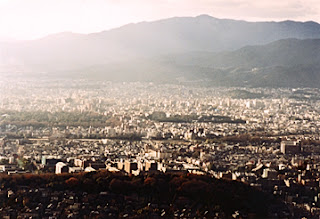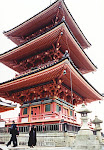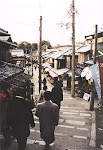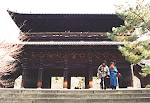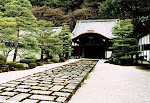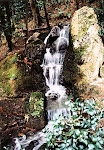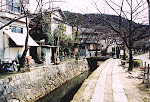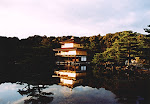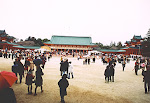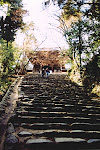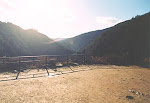![]() EN
EN
I lived in Japan from 2001 to 2004. You can read about this on my “My Experience Teaching English in Japan” page. However, I traveled a lot within Japan during my time living there as well. These travels are here on my travel pages.
Kyoto
Kyoto was the second capital of Japan, and was capital for the longest time. For that reason, it is probably the most famous city in Japan, and has many touristic and cultural attractions. People come to Kyoto to see the “old Japan”. The photo above is of the Kyoto City skyline.
This first series of photos is of Kiyomizudera Temple. This temple is a UNESCO World Heritage Site, and is one of Kyoto’s most famous sights. As is typical for Kyoto’s temples, it is set in the mountains in natural surroundings.
First row, left to right: Kiyomizudera Temple, built completely out of wood with no nails; it is common to find Shinto shrines right next to Buddhist temples, which for the Japanese is no contradiction. This is a Shinto shrine on the grounds of Kyomizudera.
Second row, left to right: this is a street with a staircase which is very close to Kyomizudera. It is called the “Two Year Staircase”, because the legend says that if you trip and fall while walking down it, you will only live for two more years! I hope these people are being careful! This staircase leads to “Teapot Alley”, which is famous for its ceramics; the area around Kiyomizudera.
Nanzenji is a popular Zen Buddhist Temple, which has a very large gate, as well as gardens and subtemples inside. In the mountains behind it there are several smaller shrines. The grounds are very big. There are many other attractive temples here, too, and they are surrounded by hills and waterfalls.
First row, left to right: the gate to Nanzenji Temple; a side temple within Nanzenji.
Second row, left to right: waterfall behind one of Kyoto’s temples; yet another gorgeous temple in Kyoto.
Left: Ginkakuji-the name of this temple means “The Silver Pavillion”. Originally the builders intended to cover all of it in silver, but this never happened, although the name was kept anyway. The garden here is one of Kyoto’s prettiest, and many locals like this temple better than its companion Kinkakuji.
Right: The Path of Philosophy. This path follows a canal that runs between Nanzenji and Ginkakuji. A Japanese philosopher apparently was able to collect his thoughts here at one time, although I find it hard to imagine that anybody can now! It is one of Kyoto’s most popular walks, but the area now looks and feels very urban.
This is Kinkakuji, the companion temple to Ginkakuji, and Kinkakuji means “Golden Pavilion”. The photos will show why that is, although Kinkakuji was left unfinished for hundreds of years, the same way Ginkakuji was. The gold coating was added only a few years ago, and now it’s Kyoto’s Number One tourist site for school groups.
Heian Jingu is Kyoto’s most famous and most important Shinto Shrine, complete with a garden and worshipping complex. These photos were taken on New Year’s Day 2002. On this day, visitors lined up to pray for good luck in the new year. Many of them dressed in traditional Japanese clothes for the occasion.
Takao is a secluded, mountainous area to the northwest of Kyoto-the photos here will give you a good idea of it. This is one of my favorite areas of Kyoto, because of the gorgeous natural scenery. The temples there are also special, as they allow you to get closer to nature, and they are much less visited and crowded by tourists. I visited Jingo-ji Temple there, and took a hike along the Hozugawa River, right around New Year’s Day 2002.

